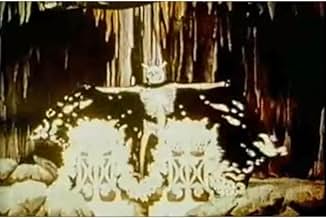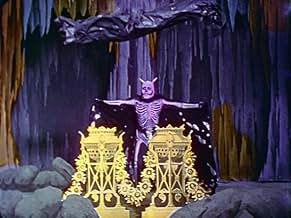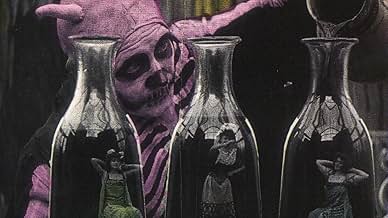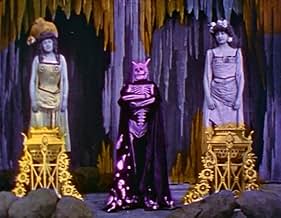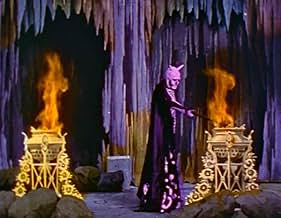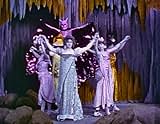AVALIAÇÃO DA IMDb
6,5/10
1,3 mil
SUA AVALIAÇÃO
Adicionar um enredo no seu idiomaA demonic magician attempts to perform his act in a strange grotto, but is confronted by a Good Spirit who opposes him.A demonic magician attempts to perform his act in a strange grotto, but is confronted by a Good Spirit who opposes him.A demonic magician attempts to perform his act in a strange grotto, but is confronted by a Good Spirit who opposes him.
Avaliações em destaque
In the late 19th and early 20th century, Georges Méliès was a very successful filmmaker. Much of it was because Méliès was originally a stage magician and he thought like one when making films. As a result, many of his films look like magic shows and the director used a lot of camera tricks to make things seemingly appear and disappear. Soon, others began copying his films....and among them, the Spaniard, Segundo de Chomón, was among the best....though his versions of the great master's films often were second-rate in quality.
"Le Spectre Rouge" is one of the best Chomón films to watch. This is because he crams every sort of camera trick into the film plus it's all in the form of a magic show. And, to get it all there, the film is about 9 minutes in length....which is amazingly long when the average movie was about one to two minutes long! As a result, you get a great homage to Méliès...one where you can see a lot of film footage showing his techniques which Chomón copied. This footage is all in the form of a weird caped skeleton-demon performing magic tricks until the tables are turned on him.
As far as how watchable all this is, it depends on you. If you love very, very early films by all means watch. Otherwise, you might find it tough going even if the film is technically brilliant.
"Le Spectre Rouge" is one of the best Chomón films to watch. This is because he crams every sort of camera trick into the film plus it's all in the form of a magic show. And, to get it all there, the film is about 9 minutes in length....which is amazingly long when the average movie was about one to two minutes long! As a result, you get a great homage to Méliès...one where you can see a lot of film footage showing his techniques which Chomón copied. This footage is all in the form of a weird caped skeleton-demon performing magic tricks until the tables are turned on him.
As far as how watchable all this is, it depends on you. If you love very, very early films by all means watch. Otherwise, you might find it tough going even if the film is technically brilliant.
Here's Segundo de Chomon challenging Melies as the master of the trick film, using the sort of magician's act that Melies did. It's a combination of stage magic and movie magic -- if you look carefully, you can see the moments when the camera stops and something is substituted.
Because whenever Melies got before the cameras and did his act -- he was a stage magician and had gotten into making movies to fill up the show at his Theatre Robert-Houdin -- you could see his pleasure in performing, there was no way that de Chomon could match that. So he stuck his unnamed performing in a skeleton costume with horns and a cape. It's so over-the-top that it's magnificent.
Because whenever Melies got before the cameras and did his act -- he was a stage magician and had gotten into making movies to fill up the show at his Theatre Robert-Houdin -- you could see his pleasure in performing, there was no way that de Chomon could match that. So he stuck his unnamed performing in a skeleton costume with horns and a cape. It's so over-the-top that it's magnificent.
This is one of the weirdest films I've ever seen from the filmmaker Segundo de Chomón--and much of this is because the film is set in Hell and the leading man is the Devil himself! Interestingly, he looks much more like a skeleton than 'Ol Scratch and he is bored. In fact, he's so bored that he decides to put on a magic show! Assisted by his main squeeze (Julienne Mathieu--the director's wife), the Devil does one trick after another after another. In fact, there are so many that it's fatiguing. It's much like watching three or four of Georges Méliès films (who Chomón is clearly copying from) and stringing them into one long film.
The film has some serious pluses--nice costumes, terrific sets and a weirdness that is wonderful. A huge minus that Chomón isn't innovating here but is 'copying' the work of another man--using a lot of the tricks innovated by Méliès. Fortunately, however, he still manages to make a very nice film.
The film has some serious pluses--nice costumes, terrific sets and a weirdness that is wonderful. A huge minus that Chomón isn't innovating here but is 'copying' the work of another man--using a lot of the tricks innovated by Méliès. Fortunately, however, he still manages to make a very nice film.
The Red Spectre (1907)
** 1/2 (out of 4)
Mildly entertaining French film from director Ferdinand Zecca was clearly influenced by the work of Georges Melies. In this film, in what appears to be Hell or something like it, a skeleton brings to life a couple women and then begins to do various tricks with them. That's pretty much everything you need to know in regards to the story as everything else is just one trick after another. There are a few good things about this film but at the same time it's just so easy to see that it's no where near the league of Melies and you have to feel that the French master was doing this type of film a decade earlier and doing it much better. I think the biggest problem is that there's really no strong pacing and after a while the 9-minute running time just feels like it's dragging along. There are several of the tricks, which simply aren't that entertaining and for one good example just check out the one where the skeleton wraps a woman up in some sort of tarp. How the trick was done is easy to spot. There are some good things however and this includes the scenery, which is quite nice to look at. The biggest highlight has to be the very good tinting and especially the reds.
** 1/2 (out of 4)
Mildly entertaining French film from director Ferdinand Zecca was clearly influenced by the work of Georges Melies. In this film, in what appears to be Hell or something like it, a skeleton brings to life a couple women and then begins to do various tricks with them. That's pretty much everything you need to know in regards to the story as everything else is just one trick after another. There are a few good things about this film but at the same time it's just so easy to see that it's no where near the league of Melies and you have to feel that the French master was doing this type of film a decade earlier and doing it much better. I think the biggest problem is that there's really no strong pacing and after a while the 9-minute running time just feels like it's dragging along. There are several of the tricks, which simply aren't that entertaining and for one good example just check out the one where the skeleton wraps a woman up in some sort of tarp. How the trick was done is easy to spot. There are some good things however and this includes the scenery, which is quite nice to look at. The biggest highlight has to be the very good tinting and especially the reds.
Also, the story for this is somewhat confusing; if I hadn't seen the brief plot summary on Letterboxd, I wouldn't know (until near the end anyway) that this was about a Good Woman fighting the devil or a demon of hell or whoever this guy in a robe and skull-face is. It seemed if it was about a woman who might have even been this demon's boss, or maybe even some annoying underling, screwing with this Demon-Man has a penchant for bottling up women (literally, you can see this in full close-up, and that's how it seems - a full 8 years before Griffith did it in in Birth of a Nation you get a close-up, albeit in camera and with separate shots without a cut).
But at any rate, this is a fun short because the filmmaking is clever and inventive: we're seeing the process this devil takes with his female wares/prisoners, and it's through blazing red and orange colors (thanks silent film technology!) and with a magician's eye for trickery. By the end 'good' does prevail, but the joy is in the evil, if that makes sense; it's filmmakers reveling in the villainy of this Demon, or at least playing with the line between showing something as being *bad* as in a devil, or something that is... enjoyable to do, like, uh, bottling up women and making them prisoners. Or slaves. Or, I don't know what. This is simply cool, and it also empowers women to fight Satan's ways at the end of it all! How to do that, well, don't look at this for answers to that question, just watch magic tricks!
But at any rate, this is a fun short because the filmmaking is clever and inventive: we're seeing the process this devil takes with his female wares/prisoners, and it's through blazing red and orange colors (thanks silent film technology!) and with a magician's eye for trickery. By the end 'good' does prevail, but the joy is in the evil, if that makes sense; it's filmmakers reveling in the villainy of this Demon, or at least playing with the line between showing something as being *bad* as in a devil, or something that is... enjoyable to do, like, uh, bottling up women and making them prisoners. Or slaves. Or, I don't know what. This is simply cool, and it also empowers women to fight Satan's ways at the end of it all! How to do that, well, don't look at this for answers to that question, just watch magic tricks!
Você sabia?
- CuriosidadesHas a link to the Assassino do Zodíaco (2005) case. A letter allegedly sent by the Zodiac Killer, who may have been a film buff, was signed "The Red Phantom" and could have referred to this film or to the color "Masque of the Red Death" sequence in Lon Chaney's 1925 O Fantasma da Ópera (1925).
Principais escolhas
Faça login para avaliar e ver a lista de recomendações personalizadas
Detalhes
- Tempo de duração
- 9 min
- Cor
- Mixagem de som
- Proporção
- 1.33 : 1
Contribua para esta página
Sugerir uma alteração ou adicionar conteúdo ausente

